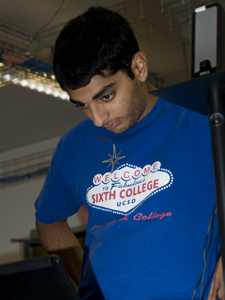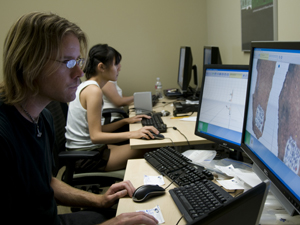Calit2 Student Researchers Participate in UCSD Summer Research Conference
By Tiffany Fox, (858) 246-0353, tfox@ucsd.edu
San Diego, Calif., Aug. 26, 2008 — Undergraduates conducting research for the UC San Diego division of the California Institute for Telecommunications and Information Technology (Calit2) presented their findings at the UCSD Summer Research Conference Aug. 14, joining more than 224 other students from universities across the country for the annual event.
|
Sponsored by the UCSD Academic Enrichment Program, the conference is the culmination of months of lab time for students like Vishal Kotcherlakota, a third-year electrical engineering major. Kotcherlakota has been toiling away in Calit2's Atkinson Hall all summer on a project in acoustic localization.
Explains Kotcherlakota: "Acoustic localization is a theory that allows you to locate an object by examining the sound waves it emits. We use time delays between microphone pairs to ascertain direction. You can think of it as a passive form of sonar. Instead of emitting a sound, the system waits for an object to emit a sound, and then begins localizing."
"What makes my system different," he continues, "is that it ditches a computationally heavy method with a lot of number crunching in favor of a distributive method which does multiple, significantly lighter computations. This will hopefully result in a method that performs at or above the level where the number-crunching method performs."
Although Kotcherlakota has been working under the mentorship of electrical engineering Professor Massimo Franceschetti for the duration of the quarter, he considers his grandfather to be his earliest role model in the field.
"Electrical engineering has been in my family for three generations. My grandfather earned his degree back when the field was called 'electronic engineering,'" he says. "As a kid, I grew up around computers and technology, and when the time came to decide what I would do for the rest of my life, it was a split between programming and engineering. I'm glad to say I made the right choice."
|
"In 'Prey,' they use biotechnology to create nanobots, which in the long run wreak havoc on everything, but I thought it was a pretty cool idea," he laughs. "Since I've come to UCSD, my scope has broadened out a little bit in terms of what I'm interested in. I don't know if I want to do research for the rest of my life. I'm interested in things like prosthetic development and the interface between computers and biology."
Gupta has gotten a good taste of what it's like to work with computers to solve biological problems this summer, having spent much of his time in UCSD's Cartilage Tissue Engineering Laboratory working with bioengineering professor Dr. Robert Sah. The researchers are developing a method to to evaluate biological slide images in a quantitative way using MATLAB, a numerical computing environment and programming language, in an effort to enhance cartilage tissue engineering. Scientists use these slides in developing treatments for osteoarthritis by staining for collagen matrix to determine how well certain cartilage tissue growth procedures have worked.
"This research is important because right now, when a researcher evaluates a slide image, the scoring is manual," Gupta explains. "Say we're staining a slide for different types of collagen. Depending on the chemical we use to stain the slide, we might get purple regions. Those regions will vary in color, intensity and size. What we want to do is be able to do is score the slides objectively, using a computer. We're trying to take something qualitative and make it quantitative."
Similarly, three undergraduates who are doing summer research for San Diego's Center of Interdisciplinary Science for Art, Architecture and Archaeology (CISA3) at Calit2 are working to make the analysis of potsherds, or fragments of ancient pottery, a more quantitative process. Under the direction of anthropology professor and CISA3 associate director Tom Levy, as well as graduate student Neil Smith, the team of student researchers have foregone research trips abroad this summer to hole up in a tiny room in Calit2's Atkinson Hall, where they've been using a Next Engine laser scanner to create computerized, 3-D images of the sherds.
Eventually, the images will be compiled into a Digital Pottery Informatics Database (DPID), which will then be linked to another project called the Digital Archaeological Atlas of the Holy Land (DAAHL), a virtual atlas of archaeological sites, artifacts and other information dating from pre-Biblical times to the early 20th century (read the full story about the DPID project).
|
"I thought it was really good, and I liked all the different topics, from biological anthropology to social anthropology," she adds. "They really had a wide variety of anthropology disciplines."
Olson, who did much of the scanning for DPID, says "some really good opportunities presented themselves" at the conference — including an invitation from the San Diego Archaeological Society to give his presentation at one of their meetings. Olson says he will be continuing his work with DPID over the next two quarters and is considering making it part of his senior thesis.
Whatever their academic discipline, the undergraduates all agree that participating in the Summer Research Conference at UCSD has been a fun, challenging and worthwhile process.
"It's been a rough ride, and I've burned the midnight oil a few times to make things work," Kotcherlakota says, "but I'm really happy with this project and with all the doors it has opened for me, including the conference. I'd like to thank Calit2 and all my mentors and the grad students kind enough to help me reach this goal. I'd like to be in the position to do the same for some lowly undergrad like myself someday."
Media Contacts
Tiffany Fox, (858) 246-0353, tfox@ucsd.edu
Related Links
CISA3
UCSD Academic Enrichment Program




